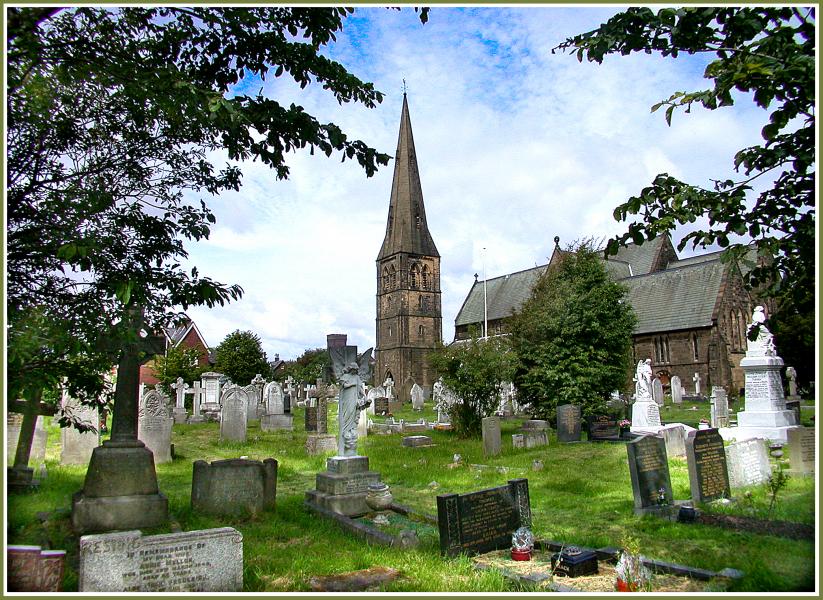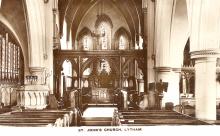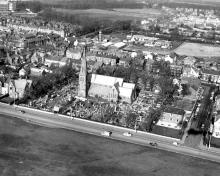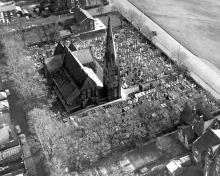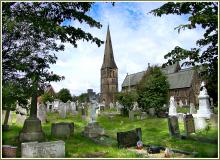The church was erected in 1848-9, and consecrated on the 11th September 1850. It was a mission church of St Cuthbert's until it became a parish in its own right in 1870. It had St. Andrew's Mission church on Victoria Street, constructed of a wooden frame with corrugated iron cladding, but this was demolished in the 1970s.
Take a look at the 150th anniversary booklet for a detailed description of the history of the church.
St. John's is an ecclesiastical parish, formed in 1870 from that of St. Cuthbert. The church, on the East beach, consecrated on 11th September 1850 is a building of stone in the Early English style, consisting of chancel, south transepts, clerestoried nave, aisles, south porch and a western tower with spire containing 6 bells : the principal windows are stained : there are sittings for 800 persons, of which 173 are free. The registers date from the year 1850. The living is a vicarage, gross yearly value £280, in the gift of J.T. Clifton esq. and held since 1870 by the Rev. Thomas Gregory Smart M.A. of Trinity College, Cambridge.
from Kelly's Lancashire Directory, 1895
It has been for many years the Lifeboat men’s church. The vicar of St John’s is Chaplain to the crew.
Church of St John the Divine, Grade II*
St John’s sits in a prime position overlooking the Green, the windmill and the Ribble estuary. It is the recognised Lifeboat Church with the Old Lifeboat house nearby.
Before St John’s was built, Lytham churchgoers faced a long walk to their only church, St Cuthbert’s, which was then beyond the western extremities of the town. In the early part of the nineteenth century the number of inhabitants and visitors started to grow, and in the summer months St Cuthbert’s was overflowing. Dwellings were springing up along the Beach and eastwards along and beyond Clifton Street, and the arrival of the railway in 1846 effectively shifted the town centre towards the east and brought the promise of even more visitors and business.
At a meeting in the Clifton Arms in late 1846 it was resolved that a new church be erected with funds raised by public subscription. One third of the seats were to be reserved for the poor. Thomas Clifton gave the land and contributed towards the endowment. Building work began in 1848 and was completed the following year at a cost of £4000. The church was consecrated in November 1850, and by 1871 the inhabitants of the new parish numbered the same as St Cuthbert’s.
Designed in early English style by Edwin Hugh Shellard of Manchester, the Church of St John, with its abundance of carved stonework and stained glass, has a wonderful medieval feel. On the exterior are six stone masks including King Ethelbert and St. Augustine on the south porch and Thomas Clifton over the vestry door. Many of the interior masks are of saints and early kings and queens. Saints also feature in some of the stained glass windows, those in the south aisle being by the designer Webb. The 1856 additions (transepts and chancel extension) were by the same architect and kept the sandstone ashlars and Cumberland slate roof style.
St John’s has a four-stage free-standing tower surmounted by a distinctive spire. In 1875 a ring of six bells was installed by the Whitechapel Foundry at a cost of £518. The bells were rehung in 1992 by Eayre and Smith Limited, Bellhangers at a cost of £15,000. Of significance is the Norman style nave with wide north and south side aisles and low-buttressed side walls.
In 1995/96 the Church was re-ordered, the font being moved to the foot of the nave, front pews removed to make more room at the chancel steps and rear pews removed to leave space for parish and social activities at the back of the Church.
Lych gate and southern boundary wall to Church of St John
Also listed are the Lych gate and the southern perimeter cobble wall. The wall, with sandstone dressings, was built at the same time as the church, but the oak timber-framed lych gate with fish scale slate roof was added later in 1897 as a memorial to the Reverend Thomas Gregory Smart, vicar from 1870-96.
from "The listed buildings of Lytham St. Annes" - Lytham St. Annes Civic Society 2003
If you have additional information or pictures that may usefully added to this page then please get in touch with us.
